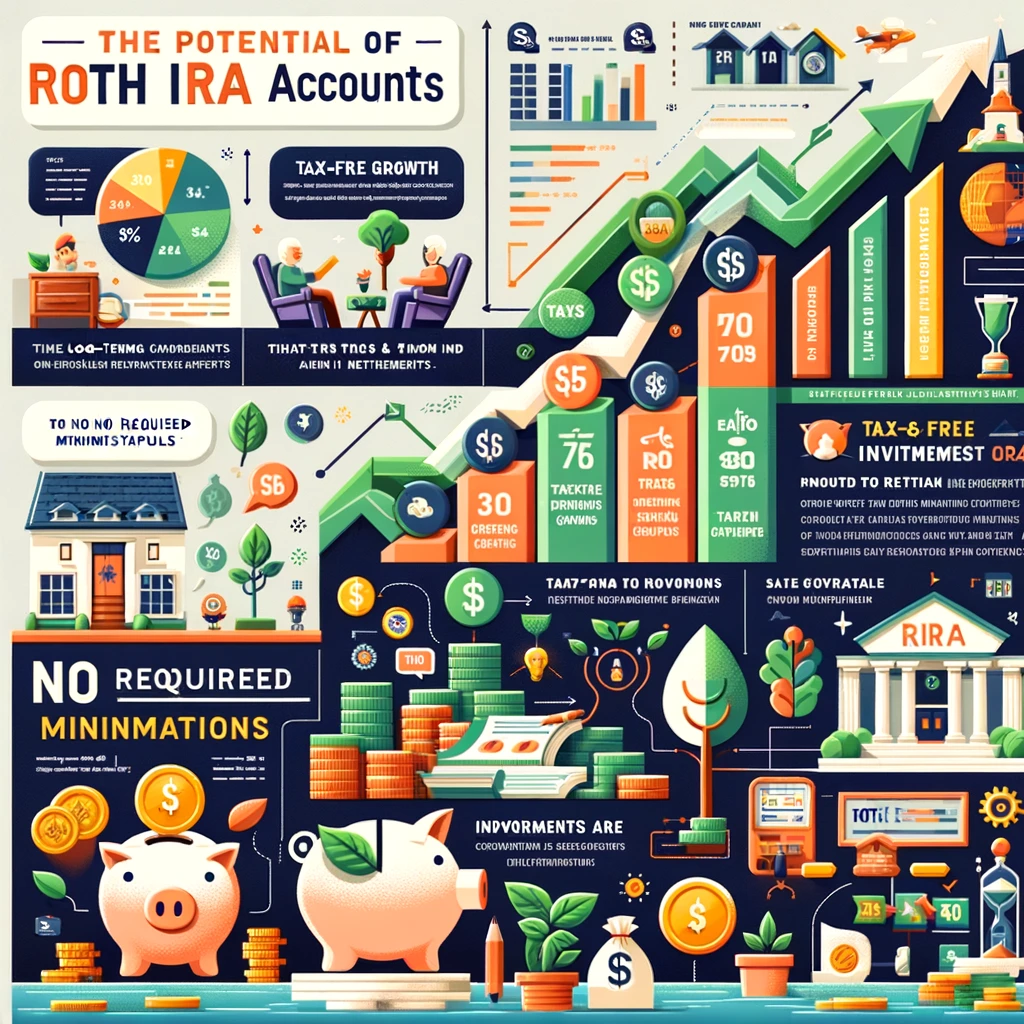Planning for retirement can be daunting, but understanding the suitable investment vehicles can ease the journey. One such powerful tool is the Roth IRA, a retirement account that offers numerous benefits and can significantly enhance your financial security. In this article, we’ll explore the ins and outs of Roth IRAs, highlighting their advantages, how they compare to other retirement accounts, and providing tips to maximize their potential.
What is a Roth IRA?
A Roth IRA (Individual Retirement Account) is a retirement savings account that allows your investments to grow tax-free. Contributions to a Roth IRA are made with after-tax dollars, meaning you don’t get a tax deduction upfront, but your earnings and withdrawals during retirement are tax-free. This can be a significant advantage, especially if you expect to be in a higher tax bracket during retirement.
Key Benefits of a Roth IRA
Tax-Free Growth and Withdrawals
One of the most compelling benefits of a Roth IRA is the tax-free growth of your investments. Once you’ve made contributions with after-tax dollars, your money grows without being subject to annual taxes. When you retire, you can withdraw your funds tax-free, provided you follow the rules set by the IRS.
Flexibility and Access
Unlike traditional retirement accounts, Roth IRAs offer more flexibility. You can withdraw your contributions (but not your earnings) at any time without penalty or taxes. This can be particularly beneficial in case of emergencies or significant financial needs before retirement.
No Required Minimum Distributions (RMDs)
Traditional IRAs and 401(k)s require you to start taking distributions at age 73, but Roth IRAs do not have RMDs during the original account holder’s lifetime. This allows your investments to continue growing tax-free for a more extended period, giving you more control over your retirement funds.
Comparing Roth IRA to Traditional IRA
It’s essential to understand the differences between a Roth IRA and a Traditional IRA to make an informed decision. While both accounts offer tax-advantaged growth, they differ in how and when you get the tax benefits.
- Traditional IRA: Contributions are tax-deductible, which reduces your taxable income in the year you contribute. However, withdrawals during retirement are taxed as ordinary income.
- Roth IRA: Contributions are made with after-tax dollars, so they do not reduce your taxable income for the year. However, both the growth and withdrawals during retirement are tax-free.
Who Can Contribute to a Roth IRA?
There are income limits to consider when contributing to a Roth IRA. For 2024, the phase-out range for single filers is $138,000 to $153,000, and for married couples filing jointly is $218,000 to $228,000. If your income exceeds these limits, your contribution limit gradually decreases and eventually phases out entirely.
Tips to Maximize Roth IRA Benefits
Start Early
The earlier you start contributing to your Roth IRA, the more time your investments have to grow. Thanks to the power of compound interest, even small contributions can grow significantly over time.
Maximize Contributions
For 2024, the contribution limit is $6,500, or $7,500 if you’re age 50 or older. Aim to contribute the maximum amount each year to take full advantage of the tax-free growth.
Diversify Your Investments
A well-diversified portfolio can help manage risk and increase potential returns. Consider a mix of stocks, bonds, mutual funds, and other assets to balance growth and security.
Reinvest Dividends
If your investments earn dividends, reinvest them to purchase more shares instead of taking them as cash. This can help accelerate the growth of your account.
Keep an Eye on Fees
High fees can eat into your returns over time. Choose low-cost investment options and be mindful of any management fees associated with your Roth IRA.
Unlock Roth IRA Benefits
Understanding Roth IRA Contribution Limits
Contributing to a Roth IRA can be a game-changer for your retirement planning, but it’s crucial to stay within the IRS-imposed limits. For 2024, individuals under 50 can contribute up to $6,500 annually, while those aged 50 and above can contribute up to $7,500, thanks to the catch-up contribution provision. By maximizing your contributions, you ensure that you’re taking full advantage of the tax-free growth and future tax-free withdrawals.
Benefits of Starting Early with Roth IRA
Time is one of the most valuable assets when it comes to investing. The sooner you start contributing to your Roth IRA, the longer your money has to grow. Starting early allows you to benefit from compound interest, where the returns on your investments generate their returns over time. Even modest contributions can grow into substantial savings, making your retirement more comfortable and secure.
Flexibility and Emergency Access
One of the standout features of a Roth IRA is the flexibility it offers. Unlike other retirement accounts, you can withdraw your contributions at any time without penalty or taxes. This can serve as a financial safety net in case of emergencies, providing peace of mind while still allowing your earnings to grow tax-free.
Long-Term Tax Planning
Roth IRAs are an excellent tool for long-term tax planning. Since withdrawals are tax-free, they can help you manage your tax bracket in retirement. By strategically planning your withdrawals from different accounts, you can minimize your overall tax burden, making your retirement funds last longer.
Real-Life Examples
To illustrate the benefits of a Roth IRA, let’s look at two scenarios:
Scenario 1: Starting Early
Jane, a 25-year-old, starts contributing $6,500 annually to her Roth IRA. Assuming an average annual return of 7%, by the time she reaches 65, her account could grow to over $1.4 million. Because her withdrawals are tax-free, Jane can enjoy a substantial income in retirement without worrying about taxes.
Scenario 2: Catch-Up Contributions
Mike, age 50, starts contributing the maximum allowed amount of $7,500 annually. With the same average return of 7%, by age 65, his account could grow to over $177,000. Even though Mike started later, he still benefits significantly from the tax-free growth and withdrawals, supplementing his other retirement income sources.
Common Roth IRA Misconceptions
“I’m too old to start a Roth IRA.”
Even if you’re approaching retirement, a Roth IRA can still be beneficial. The lack of RMDs means your money can continue to grow tax-free, providing financial flexibility later in life.
“I earn too much to contribute to a Roth IRA.”
While there are income limits for direct contributions, you can still use a strategy called the backdoor Roth IRA. This involves contributing to a traditional IRA and then converting those funds to a Roth IRA, allowing high-income earners to take advantage of Roth benefits.
Conclusion: Secure Your Future with a Roth IRA
A Roth IRA is a powerful tool for securing your financial future. Its tax-free growth, flexibility, and lack of required minimum distributions make it an attractive option for many investors. By understanding the benefits and strategically contributing to your Roth IRA, you can build a substantial nest egg that supports a comfortable and tax-efficient retirement. Whether you’re just starting or looking to diversify your retirement savings, a Roth IRA offers significant advantages that can help you achieve your long-term financial goals.
Unlock the benefits of a Roth IRA today and take a proactive step toward a secure and prosperous retirement.






